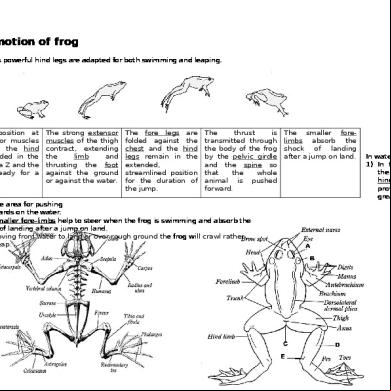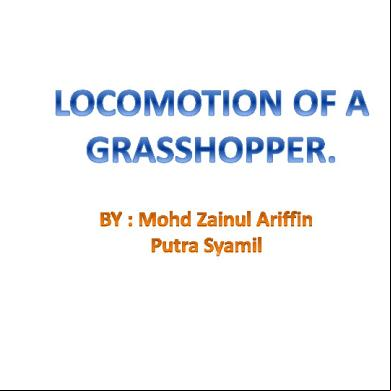Locomotion Of Frog 1h73w
This document was ed by and they confirmed that they have the permission to share it. If you are author or own the copyright of this book, please report to us by using this report form. Report 3i3n4
Overview 26281t
& View Locomotion Of Frog as PDF for free.
More details 6y5l6z
- Words: 321
- Pages: 2
Locomotion of frog
On land The frog's powerful hind legs are adapted for both swimming and leaping.
In the position at rest (flexor muscles contract), the hind leg is folded in the shape of a Z and the frog is ready for a jump.
The strong extensor muscles of the thigh contract, extending the limb and thrusting the foot against the ground or against the water.
The fore legs are folded against the chest and the hind legs remain in the extended, streamlined position for the duration of the jump.
The thrust is transmitted through the body of the frog by the pelvic girdle and the spine so that the whole animal is pushed forward.
surface area for pushing backwards on the water. 2) The smaller fore-limbs help to steer when the frog is swimming and absorb the shock of landing after a jump on land. 3) On moving from water to land or over rough ground the frog will crawl rather than leap.
The smaller forelimbs absorb the shock of landing after a jump on land.
In water 1) In the water the webbed hind feet provide a greater
Adaptation
Explanation
1) The tibia, fibula, and tarsals have been fused into a single, strong bone that is heavily muscled.
Great force is produced for jumping.
2) Have the radius and ulna in the fore limbs
absorb the impact on landing
3) The metatarsals have become elongated to add to the leg length
allow the frog to push against the ground for a longer period on take-of
4) The tail vertebrae have fused into an urostyle which is retracted inside the pelvis.
This enables the force to be transferred from the legs to the body during a leap.
5) Almost all muscles have been modified to contribute to the action of jumping, with
only a few small muscles remaining to bring the limb back to the starting position and maintain posture.
On land The frog's powerful hind legs are adapted for both swimming and leaping.
In the position at rest (flexor muscles contract), the hind leg is folded in the shape of a Z and the frog is ready for a jump.
The strong extensor muscles of the thigh contract, extending the limb and thrusting the foot against the ground or against the water.
The fore legs are folded against the chest and the hind legs remain in the extended, streamlined position for the duration of the jump.
The thrust is transmitted through the body of the frog by the pelvic girdle and the spine so that the whole animal is pushed forward.
surface area for pushing backwards on the water. 2) The smaller fore-limbs help to steer when the frog is swimming and absorb the shock of landing after a jump on land. 3) On moving from water to land or over rough ground the frog will crawl rather than leap.
The smaller forelimbs absorb the shock of landing after a jump on land.
In water 1) In the water the webbed hind feet provide a greater
Adaptation
Explanation
1) The tibia, fibula, and tarsals have been fused into a single, strong bone that is heavily muscled.
Great force is produced for jumping.
2) Have the radius and ulna in the fore limbs
absorb the impact on landing
3) The metatarsals have become elongated to add to the leg length
allow the frog to push against the ground for a longer period on take-of
4) The tail vertebrae have fused into an urostyle which is retracted inside the pelvis.
This enables the force to be transferred from the legs to the body during a leap.
5) Almost all muscles have been modified to contribute to the action of jumping, with
only a few small muscles remaining to bring the limb back to the starting position and maintain posture.





